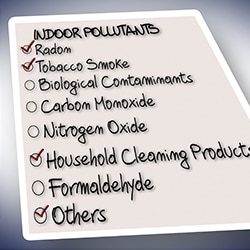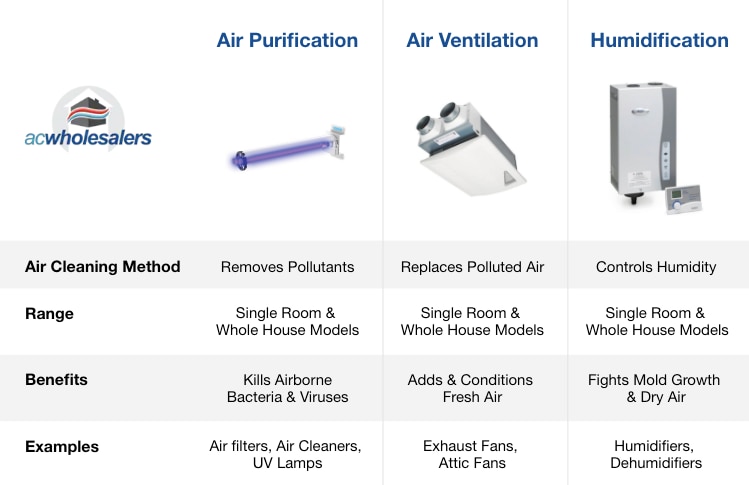How to Improve Air Quality in Your Home
Indoor Air Quality Guide
Do you really know what you are breathing? When it comes to indoor air quality, many of us follow the mantra, “If you can’t see it, it can’t hurt you.”
In reality, depending on where and how you live, there could be a wide range of contaminants in your home’s air, including volatile organic compounds, smoke, pet hair, mold, or even industrial pollution. We'll go over what those are and how to improve air quality in your home.
Indoor Air Pollution Sources

If you regularly smoke, own pets that shed, have carpeting covering your floor, enjoy hobbies that involve heavy woodworking or painting, etc., then your home is at higher risk for having poor indoor air quality. Sometimes it’s nothing that you’re doing. For example, houses built before 1981 could contain deadly asbestos.
Basically, anytime you’re putting something into the air that isn’t being vented out or filtered properly, it can accumulate and cause breathing or other health problems, especially for those with allergies or asthma.
There are three ways to improve indoor air quality:
- Air Purification: Removing contaminants from the air.
- Air Ventilation: Replacing the Air.
- Humidification: Increasing or decreasing the amount of water vapor in the air.
Each solution below falls into one of these three categories. Air filters, air cleaners, and UV are types of air purification. Exhaust and attic fans are types of ventilation. Humidifiers/dehumidifiers control moisture. ERVs and HRVs can ventilate and/or control moisture. 
Media Air Filters
Although you may currently be opting for the lowest-cost filters, know that you get what you pay for. Filters are rated on a MERV scale of 1-16. Lower-cost filters have a lower MERV rating, meaning they can only capture the largest air particles like dust and fibers.
A few extra dollars will buy you a filter capable of blocking finer particles like mold spores, tobacco smoke, or even some bacteria to really improve home air quality. Not everyone needs this level of protection, but if you have many different sources of pollution, you will benefit.
Just keep in mind that while the higher MERV filters block more contaminants, they also block more air in general, which can slowly suffocate your heating and cooling system if it’s not set up properly. Always check with your contractor about what your system can handle.
Air Cleaners
Unlike with media air filters, there’s no replacement needed with electronic air cleaners. Just take out and wash the main electrostatic filter about once a month.
Powerful HEPA air cleaners are a step-up, incorporating an activated carbon prefilter and a VOC after-filter for up to 99.97% efficiency against air particles.
Electronic and HEPA air cleaners are a great option for those with respiratory issues who need finer particles filtered out of their home’s air, although it will cost more and require professional installation.
UV Lamps
UV lamp kits come in various types. Some plug into the wall, while others are wired into your HVAC system to disinfect passing air and the air conditioning coil. UV light can kill most bacteria and viruses depending on exposure time, so it can be helpful during cold and flu season.
The UV bulbs do burn out, however, so you do need to monitor and replace them roughly once a year. Many systems come with a monitor that alerts you when it's time to change the bulb. Learn more about UV lamps.
Exhaust Fans
Bathroom fans are one of the most common types of exhaust fans. An electric motor sucks the humid and smelly air from your bathroom, and then ductwork exhausts it outside. Some bathroom fans have smart capabilities like motion sensing and humidity-sensing options.
Range hoods, or oven fans, are another example of a home exhaust fan. When you’re cooking that garlic-heavy recipe or accidently burn something, range hoods help eliminate the odor and CO emissions.
Although kitchen and bath fans are standard in most homes, you may have an outdated or poorly-functioning model that isn’t doing much. For the sake of indoor air quality, it may be time for an upgrade.
Attic Fans
Although their primary benefit is to help cool your home during the hot summer months, attic fans can also improve air quality in your home.
Granted, attic fans draw in outdoor air which may contain allergens and other pollutants, but if you’re a heavy smoker or own pets, the tradeoff might be worth it. Plus, remember that outdoor air is typically less polluted than indoor air, so you're still freshening things up. Learn more in our whole house fan buyer's guide.
HRVs & ERVs
An HRV uses one, incoming, air stream to draw fresh outdoor air into the home and filter it. A second, outgoing, air stream exhausts stale indoor air outside. Inside the HRV, both air streams pass each other without mixing. However, during wintertime, the warmer outgoing air can heat up the cold incoming air so you don’t drastically lower your home’s temperature.
An ERV also has incoming and outgoing air streams. The difference is the ability of the outgoing, less-humid air to absorb some humidity from the incoming humid air. Perfect for humid places like the southeast, ERVs help reduce moisture in the home and can also act as HRVs on colder days.
As you can see, the indoor air quality benefits of HRVs/ERVs are significant and the units are very reasonably priced.
Humidifiers/Dehumidifiers
If too much humidity is the problem, then a dehumidifier can remove the moisture from your home’s air. The summer months are typically when humidity’s effects are felt most strongly, so that’s the perfect time to run a dehumidifier. Learn more about dehumidifiers.
During the wintertime, indoor humidity levels are often lower thanks to our heating systems. A humidifier can pump precious moisture into your home to give your dry, itchy hands a relief.
Breathe Better at Home
When it comes to breathing better at home, you have many options. Removing indoor air pollutants and improving indoor air quality can do wonders for your physical health and well-being.
If your head is spinning after learning about all these options, please contact us to speak with an expert about what's best for you.
NEXT: Shop Indoor Air Quality Products
